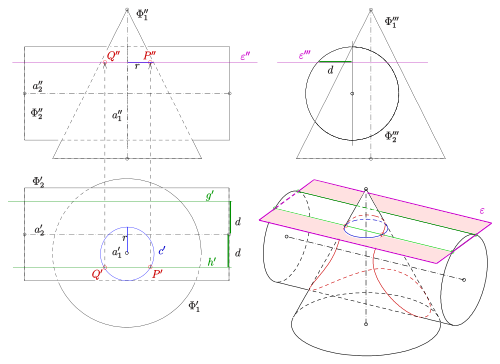Auxiliary level method
The auxiliary plane method is a method of descriptive geometry to determine the penetration curve (intersection curve) of two surfaces ( cylinder , cone , sphere , torus ) in a two- panel projection point by point. However, this method is only practical if there are planes that intersect the given surfaces in straight lines or circles and these are then also parallel to the floor plan or elevation. These conditions severely limit the possible cases. Nevertheless, many cases that occur in practice can be solved with it.
In addition to the auxiliary plane method, there is also the pendulum plane method and the auxiliary sphere method .
Computational methods for determining points on an intersection curve are explained in the article Intersection curve .
Description of the process using an example
A cone (axis ) and a cylinder (axis ) are given in plan, elevation and side elevation (see picture). Find the penetration curve of the two surfaces.
- Choose a suitable plane parallel to the floor plan that intersects both surfaces and draw the elevation and side elevation .
- Draw the outline of the cutting circle (radius r).
- Determine the distance in the side plan and draw the parallels to in the distance in the floor plan .
- The (max. Four) points of intersection of the circle with and are the outline of points on the penetration curve.
- To obtain about folders then .
- Repeat 1st to 5th n times.
- Connect the points in the "correct" order with a curve.
See also
literature
- Fucke, Kirch, Nickel: Descriptive Geometry. Fachbuch-Verlag, Leipzig, 1998, ISBN 3-446-00778-4
- Cornelie Leopold : Geometric Basics of Architecture , Verlag W. Kohlhammer, Stuttgart, 2005, ISBN 3-17-018489-X
Web links
- Descriptive geometry for architects (PDF; 1.5 MB). Script (Uni Darmstadt)

















